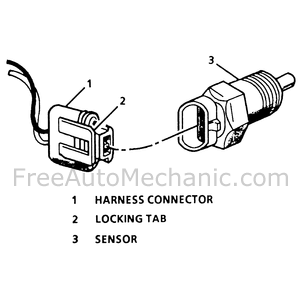CTS - Coolant Temperature Sensor
Coolant Temperature Sensor (CTS)
OPERATIONThe Engine Coolant Temperature (ECT) sensor, sometimes referred to as the Coolant Temperature Sensor (CTS), is a thermistor (resistor which changes value based on temperature) mounted in the engine coolant stream. Low coolant temperatures produce a high resistance — 100,000 ohms at −40°F (−40°C), while high temperatures cause low resistance — 70 ohms at 266°F (130°C).
Fig. 1: Engine Coolant Temperature (ECT) sensor and connector

The control module provides a 5 volt reference signal to the sensor through a resistor in the module and measures the voltage. The voltage will be high when the engine is cold and low when the engine is hot. By measuring the voltage, the control module knows the engine coolant temperature. The engine coolant temperature affects most other systems controlled by the module.
Coolant Temperature Sensor Symptoms
- Extended crank time when the engine is cold
- Poor fuel economy
- Spark knock
- Lack of engine power
- Erratic and/or high idle
- Engine cooling fan stays running all the time
- Engine cooling fan fails to turn on
- Engine overheating
Coolant Temperature Sensor Testing
- Disconnect the temperature sensor.
- Connect an ohmmeter between the sensor terminals.
- Measure the resistance with the engine off and cool. Then measure with the engine running and warmed up. Compare the resistance values obtained with the chart.
- Replace the sensor if the readings are incorrect.


Car Engine Sensors :
- Powertrain Control Module (PCM)
- Throttle Position (TP) sensor
- Mass Air Flow (MAF) sensor
- Intake Air Temperature (IAT) sensor
- Idle Air Control (IAC) valve
- Engine Coolant Temperature (ECT)
- Heated Oxygen Sensor (HO2S)
- Camshaft Position (CMP) sensor
- Knock Sensor (KS)
- Vehicle Speed Sensor (VSS)
- Crankshaft Position (CKP) sensor
- Engine Trouble Codes


